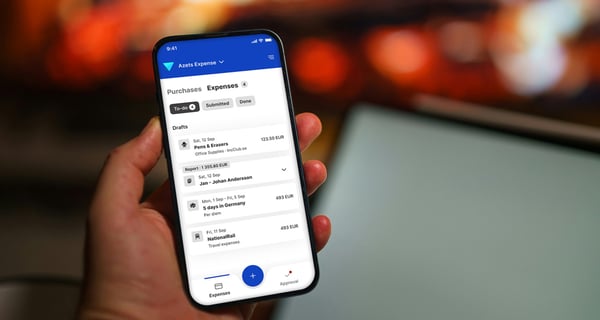
%20(1).jpg?width=1440&name=pexels-marcus-aurelius-6787934%20(1)%20(1).jpg)
On average, it costs companies nearly $60 USD to process one expense report. Multiply that by the number of employees making claims each month, factor in the additional time and cost of manually correcting errors – and the true cost of expense management adds up quickly.
That’s why forward-thinking organisations are increasingly making use of the time and cost-saving potential of automated expense reporting. In this blog post, we take a closer look at the reporting process and the business benefits of digital automation.
What Is An Expense Report?
An expense report is a categorised list of business expenses incurred by an employee in order to complete work-related duties on behalf of their employer. It includes things like travel, subsistence, per diem, and mileage.
The employee records the expenses and submits them for approval in the form of a report. Once approved, the report goes to the finance team, who checks the accuracy, validates the claim, posts the expense to accounting software, and then authorises the reimbursement.
The following information is typically needed to report expenses:
- Employee name, role, and payroll number
- Date expense incurred
- Type of expense
- The expense amount
- Payment type (cash or card)
- Subtotals of each expense type
- Total cost of the expenses
- Paper or digital receipts
When an employee makes a purchase on behalf of the company, all supporting documents – receipts in most cases – need to be saved and submitted to an accounting system to facilitate reimbursement. If the employee has several receipts for the same trip, they are collated in one expense report. In this way, all business expenses are correctly included in the company’s accounts.
Why Do Expense Reports?
Every company has their own internal policy on expenses, setting out what can and can’t be expensed. By offering a standardised approach for claiming expenses – in the form of expense reports – it’s easier to ensure compliance and legitimacy.
Expense reports should make it straightforward for employers and their finance teams to account for expenditures in the correct way, calculate the impact on their profits, and determine the correct taxation rules to apply.
Not all expenses are tax-deductible, so it’s important to determine the status of each claim and account for it accordingly. In most countries, it’s also essential to have proof of each claim in the form of paper or digital receipts.
The beauty of expense reports is that when done accurately and efficiently, they make compliance with tax regulations, and the completion of financial audits, much easier. At the same time, they enable business budgeting to be much more efficient, providing oversight of spending to ensure departments and individuals keep within their agreed limits.
By tracking spending over time, companies can identify areas to cut costs. For example, employees might be overspending in a particular category or a preferred vendor might have less competitive rates – prompting a change. From an employee perspective, expense reports help to ensure fair and accurate reimbursement, especially when employees have incurred business expenses and paid for them out of their own pockets.
However, problems arise when human errors are made, or paper receipts are lost. This is especially true of manual processes, which rely on accurate data entry and the submission of paper documents.
Manual Expense Process
With a manual process for expense reporting, in order to be reimbursed, the employees submit all of their physical receipts. When the costs are posted, each voucher number must be written on the manual expenditure report, so the voucher can be matched with the correct supporting documentation.
After each claim is validated, the accountant has to book in each individual receipt to facilitate reimbursement. If there’s an error, a missing document, or an invalid claim, they may have to return the report to the employee.
A manual process relies on employees reading, understanding, and applying company policy and governmental regulations regarding expenses. As this quickly gets complicated, it’s no wonder that employees can sometimes get it wrong.
When people are on the move, it’s easy to see how small pieces of paper – such as receipts – can get lost, damaged, or misplaced. When this does inevitably happen, relying on manual processes makes it almost impossible to validate an expense claim.
Automated Expense Reporting
Automated expense reporting is one way to improve expense management. Here are the key benefits:
Reduced Errors
By removing the manual steps in expense reporting, it’s possible to save time and reduce the likelihood of human errors from both the employee and the administrator’s side of things – firstly, when transferring information from multiple pieces of paper into a paper report or spreadsheet, and secondly, when manually keying in information into accounting software.
Quicker Reimbursement
No-one likes waiting for reimbursement. When finance teams are handling and verifying multiple paper-based expense claims against receipts from different employees – it can take a long time to process reimbursements – especially when waiting for different levels of approval. Automation can help to streamline workflows with prompts and notifications that expedite processing and reduce the time to reimbursement.
Accounting Compliance
By automating expense reporting, employers can tailor the process to both internal policy and regulatory requirements. The right automated expense management tool will track changes to financial regulations and tax laws, so when it comes to expenses and accounting compliance, you can be sure that your data is correct according to local regulations.
Greater Visibility
If you’ve ever trawled through multiple records to gain cost-saving insights into company expenses, you’ll appreciate the value of good visibility. Manual searches take time. When you automate expense management, you accelerate the speed at which expense data travels through your finance systems, so it’s ready and waiting to be extracted for analysis. With just a few clicks, you can quickly and easily pull data on different expense types and identify common instances of policy breaches – finding new opportunities for cost reduction.
Fraud Prevention
As the receipts and expense reports pile up, manual expense management can quickly become unmanageable, leaving companies wide open to inaccurate reporting and misuse of your expense policy. Either intentionally or unintentionally, sometimes claims can go twice through the system, and if you’re not careful, result in duplicate reimbursement. With expense management automation, every claim is cross-checked and verified before reimbursement is made.
Need help choosing the right automated expense management solution for your business? Read our short guide.
Simplify Expense Claims
For those employees incurring business expenses, automated reporting begins with a smartphone camera, and photos of their paper receipts. With Findity’s built-in OCR scanner, receipts are automatically interpreted with the correct amount, VAT, and expense category.
In most countries around the world, even with automated reporting, paper receipts are still needed, but in some countries they can be submitted at a later date. Whatever the local regulations, Findity can help you stay compliant.
Automation can also help to streamline workflows for everyone involved in expense management:
- The employee submits the report.
- Their manager is notified to approve the claim.
- An administrator checks the report, then posts it to the accounting system.
- Payroll makes the reimbursement.
Automations makes reporting expenses much faster, and by scanning in paper receipts, it’s also easier to keep track because everything is in one place.
Want to see how quick and easy expense reporting can be? Watch this short video guide to simplified expense management from Findity:



